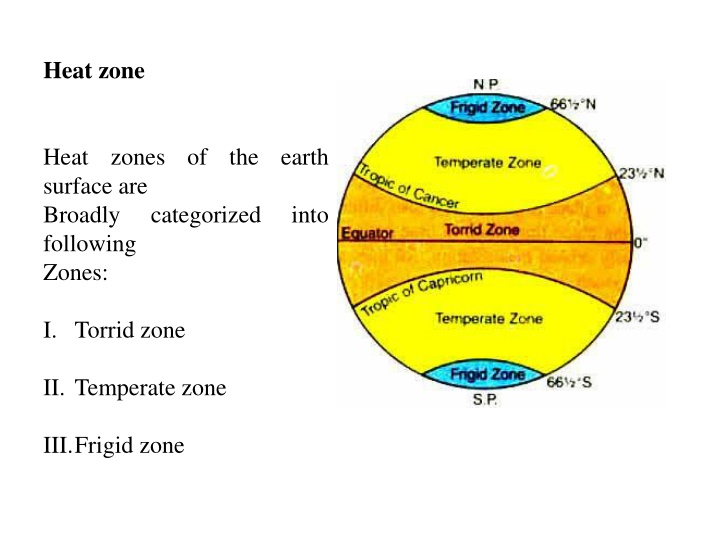Earth's Heat Zones and Celestial Events Explained
Heat zones of the earth surface are categorized into Torrid, Temperate, and Frigid zones. The Torrid Zone lies between the Tropic of Cancer and the Tropic of Capricorn, experiencing the most direct sunlight. The Temperate Zones have milder climates and are situated between the Arctic and Antarctic Circles. The Frigid Zones encompass the poles and are characterized by extreme cold temperatures. Additionally, the content discusses the concepts of Perihelion, Aphelion, Solstices, and Equinoxes, highlighting the Earth's orbit around the sun and the variations in daylight throughout the year.
Download Presentation

Please find below an Image/Link to download the presentation.
The content on the website is provided AS IS for your information and personal use only. It may not be sold, licensed, or shared on other websites without obtaining consent from the author.If you encounter any issues during the download, it is possible that the publisher has removed the file from their server.
You are allowed to download the files provided on this website for personal or commercial use, subject to the condition that they are used lawfully. All files are the property of their respective owners.
The content on the website is provided AS IS for your information and personal use only. It may not be sold, licensed, or shared on other websites without obtaining consent from the author.
E N D
Presentation Transcript
Heat zone Heat zones of the earth surface are Broadly categorized following Zones: into I. Torrid zone II. Temperate zone III.Frigid zone
Torrid Zone The Torrid Zone is located between the Tropic of Cancer at 231/2 N and the Tropic of Capricorn at 231/2 S, covers 39.78% of Earth's surface. This zone is bounded on the north by the Tropic of Cancer and on the south by the Tropic of Capricorn; these latitudes mark the northern and southern extremes in which the sun passes directly overhead Temperate Zone The North Temperate Zone, between the Arctic Circle at 661/2 N and the Tropic of Cancer at 231/2 N, covers 25.99% of Earth's surface. The South Temperate Zone, between the Tropic of Capricorn at 231/2 S and the Antarctic Circle at 661/2 S, covers 25.99% of Earth's surface. In the two temperate zones, consisting of the tepid latitudes, the Sun is never directly overhead, and the climate is mild, generally ranging from warm to cool.
Frigid Zone The North Frigid Zone, between the North Pole at 90 N and the Arctic Circle at 661/2 N, covers 4.12% of Earth's surface. The South Frigid Zone, from the Antarctic Circle at 661/2 S and the South Pole at 90 S, covers 4.12% of Earth's surface. In the center of the zone (the pole) the day is one year long with six months of daylight and six months of night. The frigid zones are the coldest regions of Earth and are generally covered in ice and snow. It receives slanting rays of the sun as this region lies farthest from the equator
Perihilion, Aphelion, Solastice and Equinox 3rd January 4th July
Aphelion is the point of the Earths orbit that is farthest away from the Sun. Each year on July 4th the earth little furthe from the sun at distance 152 million km. Perihelion is the point of the Earth s orbit that is nearest to the Sun. Each year on January 3rd the earth come close to the sun at distance 147 million km. The day of a solstice in either hemisphere has either the most sunlight of the year (summer solstice) or the least sunlight of the year (winter solstice) for any place other than the Equator.























